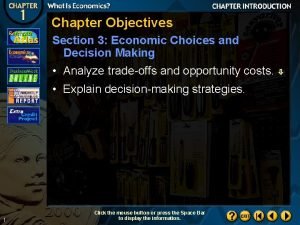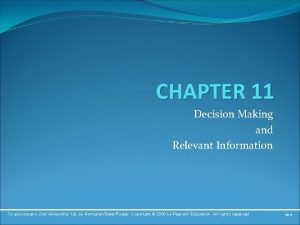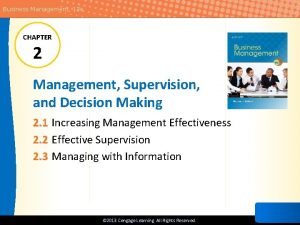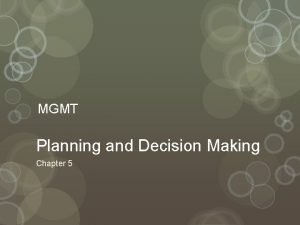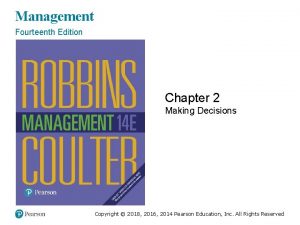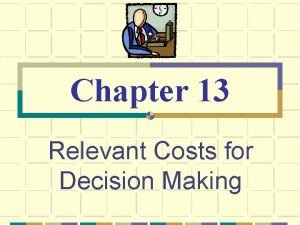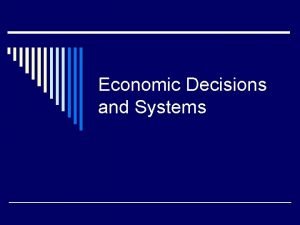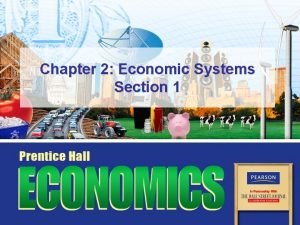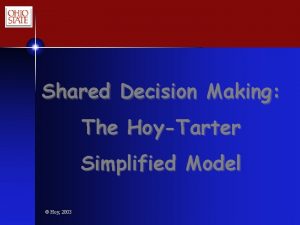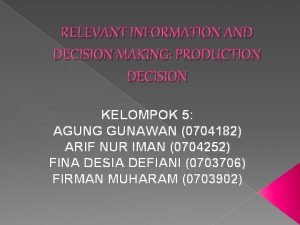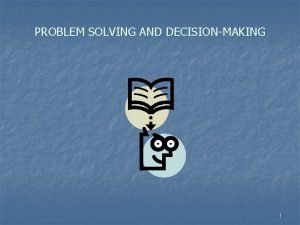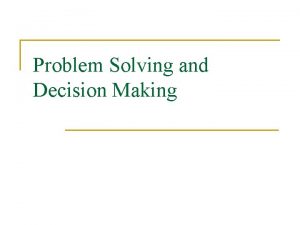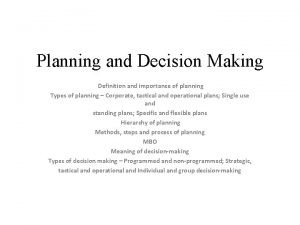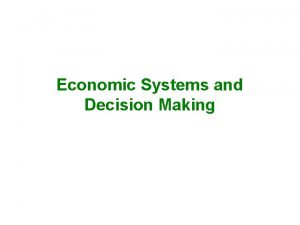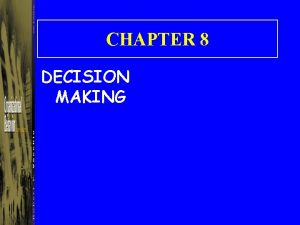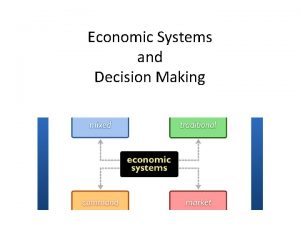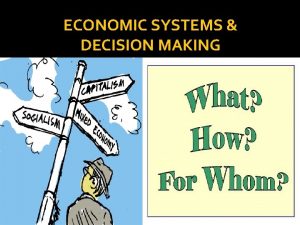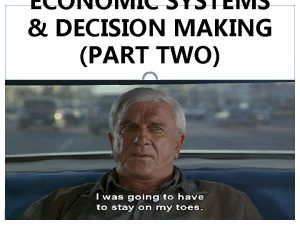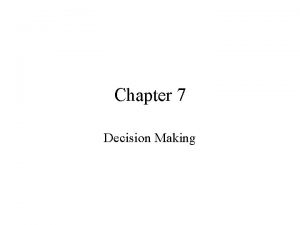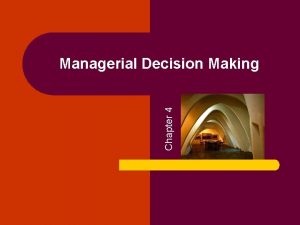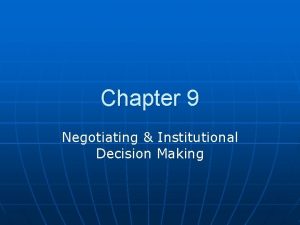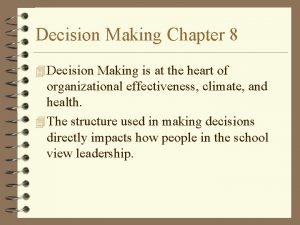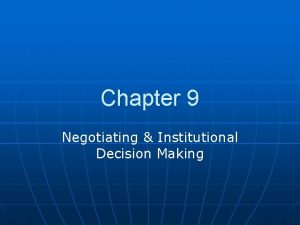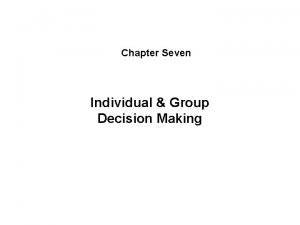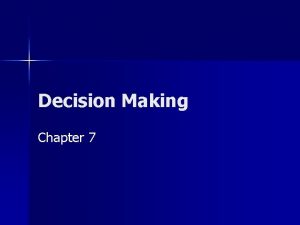Economic Systems and Decision Making Chapter 2 What






























- Slides: 30

Economic Systems and Decision Making Chapter 2

What is an Economic System? The method used by a society to produce and distribute goods and services Economic systems across the world are the product of many factors: political structures, resources, culture, social systems, technology, and even geography. The economic systems of most countries embody one of three major economic structures: free enterprise economies, command economies, or mixed economies.

The Three Basic Questions: Determining a Society’s Economic System Because ALL economic resources are scarce, every society must answer three questions: – What goods and services should be produced? • Guns or butter? – How should these goods and services be produced? • What combination of factor resources should we use? – Who consumes these goods and services? • How will income be distributed?

Every society has some system or mechanism that transforms that society’s scarce resources into useful goods and services.


Four Economic Systems An economic system is the method used by a society to produce and distribute goods and services. Traditional economies rely on habit, custom, or ritual to decide what to produce, how to produce it, and to whom to distribute it. In a Market economy economic decisions are made by individuals and are based on exchange, or trade. In a Command economy the central government makes all decisions about the production and consumption of goods. Mixed economies are systems that combine tradition and the free market with limited government intervention.

Comparing Economic Systems Economic System Who answers the 3 ? ’s • • Traditional Market Command Mixed Customs Individuals Central Government Individuals with some government involvement

Traditional Economy • Found in rural, underdeveloped countries– – – Vanuatu Pygmies of Congo Eskimos & Indian tribes African Mbuti • Customs govern the economic decisions that are made • Farming, hunting and gathering are done the same way as the generation before • Economic activities are centered around the family or ethnic unit • Men and women are given different economic roles and tasks • Advantages: people have specific roles; security in the way things are done • Disadvantages: Technology is not used; difficult to improve

A Tale of Wakanda!

Economic Systems Most Common Around the World Today…

Command Economy • The government (or central authority) determines what, how, and for whom goods and services are produced. • A command economy can be headed by a king, a dictator, a president, a tribal leader, or anyone else who makes the major economic decisions. • A modern, and somewhat more liberal, version of the command economy is socialism. • There are no pure Command Economies…closest example is North Korea. • Advantages – Guarantees equal standard of living for everyone – Less crime and poverty – Needs are provided for through the government • Disadvantages – Minimal choices – Fewer choices of items – No incentive to produce better product or engage in entrepreneurship • Also known as a Planned or Managed Economy

Historically, command economies face problems of poor-quality goods, shortages, and diminishing production.


Market Economy (Free Enterprise) • Also called a Free Market Economy or Free Enterprise • Economy, or MARKET ECONOMY • Market Economies are when supply, demand the price system help people allocate resources and make the What, • How, and For Whom decisions. • Businesses and consumers decide what they will produce • and purchase and in what quantities (Voluntary • Exchange) Supply and demand of goods and services determine what is produced and the price that will be charged. Advantage—competition to have innovative products and services Disadvantage—huge rift between wealthy and poor Note: a true market economy does not exist.


• A Market economy is often described as being based on CAPITALISM, a economic system where private citizens own and use the factors of production for their own profit or gain. • The term CAPITALISM draws attention to the private ownership of resources, while the term MARKET ECONOMY focuses on where the goods and services are exchanged. • The two terms focus on different features of the same economic system.

Free Markets Circular Flow Diagram of a Market Economy • In a free market economy, households and business firms use markets to exchange money and products. Households • Households own the factors of production and consume goods and services. monetary flow physical flow Firms physical flow monetary flow

Advantages of the Market Economic Efficiency • As a self-regulating system, a free market economy is efficient. Economic Growth • Because competition encourages innovation, free markets encourage growth. Economic Freedom • Free market economies have the highest degree of economic freedom of any economic system. Additional Goals • Free markets offer a wider variety of goods and services than any other economic system.

Mixed Economies • It is doubtable that any nation can exist successfully under a pure command economy or a pure market economy. • Most economies mix features of both systems. • Three market types are extremes, but the world is more diverse and complicated. • Major events can change a country to be more of a mixed economy… like the Great Depression.

Mixed Economy • Combination of a market and a command economy • Government takes care of people’s needs • Marketplace takes care of people’s wants. • Advantage —balance of needs and wants met by government and in marketplace • Disadvantage —citizens have to pay taxes • United States, England, Australia, Japan, China…yes even China! Most nations have a mixed economy

Examples of Mixed Economies pg. 51 In a mixed economy, the government owns both land capital. The government and the market decide what to produce, how much to produce, and how much to charge. But to what degree the government is involved will determine if it is Communist, Mixed Socialism, or Mixed Market (Capitalism) Communist: economic and political system in which factors of production are collectively owned but directed by the state and all private property is abolished; a theoretically classless society in which everyone works for the common good. In reality, no nation has ever achieved this economic goal. Mixed Socialism: Under socialism, the government owns and controls most, but not all, of the basic productive resources. In most socialist economies, the government provides a spectrum of the basic needs of its people, such as education, jobs, transportation, and health care. Many nations who are believed to be communist are actually socialist. China and Russia

Mixed Market Economies • Many examples exist of Mixed Market economies, especially in Democratic countries. (Countries with Democracy) • These countries have a mixed economy based on Capitalism, however also have some elements of socialism. • Usually, the more programs & more government influence, the higher the taxes for citizens. • Examples include; Norway, Sweden (once knick-named “the socialist state that works”), Denmark, France, Germany, and the United States. • Any country which provides significant social program benefits would fit into this category. • South Korea, India and Thailand also have mixed market economies, but also mix in elements of traditional economies.

Comparing Mixed Economies Continuum of Mixed Economies Centrally planned Free market Iran North Korea Cuba South Africa China Russia France Botswana Greece United Kingdom Canada Peru Source: 1999 Index of Economic Freedom, Bryan T. Johnson, Kim R. Holmes, and Melanie Kirkpatrick Hong Kong Singapore United States


Modern Capitalism United States • Most decisions are made by individuals and businesses with a focus on minimal government interference. • Government involvement is in terms of regulations (laws), and services considered to be essential. • Is the type of mixed economy with the least amount of government involvement.

The American Free Enterprise System Chapter 3 When/how should the U. S. Government interfere with the economy? • Simply put, capitalism is the most powerful engine for generating wealth the world has ever seen. • Key elements of a free enterprise system include: voluntary exchange, consumer sovereignty, private property, competition, individual freedom, and profit motives. • Role of the GOVERNMENT: Protector, provider, and regulator. (also, consumer!)




 Chapter 2 economic systems and decision making answer key
Chapter 2 economic systems and decision making answer key Chapter 2 economic systems and decision making
Chapter 2 economic systems and decision making Chapter 2 economic systems and decision making
Chapter 2 economic systems and decision making Chapter 1 section 3 economic choices and decision making
Chapter 1 section 3 economic choices and decision making Objectives of decision making
Objectives of decision making Slidetodoc.com
Slidetodoc.com Lesson 2 our economic choices
Lesson 2 our economic choices How do information systems aid in decision making
How do information systems aid in decision making Decision support systems and intelligent systems
Decision support systems and intelligent systems Chapter 6 prices and decision making assessment answers
Chapter 6 prices and decision making assessment answers Chapter 11 decision making and relevant information
Chapter 11 decision making and relevant information Management chapter 5 planning and decision making
Management chapter 5 planning and decision making Chapter 11 decision making and relevant information
Chapter 11 decision making and relevant information Chapter 2 management supervision and decision making
Chapter 2 management supervision and decision making Chapter 11 decision making and relevant information
Chapter 11 decision making and relevant information Options-based planning
Options-based planning Financial decision-making process
Financial decision-making process Chapter 2 decision making
Chapter 2 decision making Relevant cost for decision making solution chapter 13
Relevant cost for decision making solution chapter 13 Chapter 1 economic decisions and systems answer key
Chapter 1 economic decisions and systems answer key Chapter 2 economic resources and systems
Chapter 2 economic resources and systems Growth and development conclusion
Growth and development conclusion Chapter 2 economic systems answer key
Chapter 2 economic systems answer key Decision table and decision tree examples
Decision table and decision tree examples Mamdm
Mamdm Using functions in models and decision making
Using functions in models and decision making Hoy and tarter decision making model
Hoy and tarter decision making model Decision making and relevant information
Decision making and relevant information Best books on problem solving and decision making
Best books on problem solving and decision making Individual and group decision making
Individual and group decision making Nature of decision making
Nature of decision making



